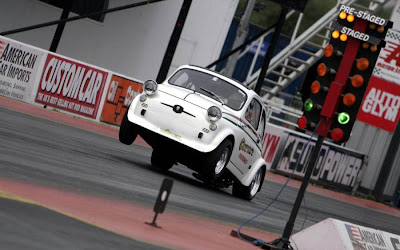
i started to wonder - where are physical limits of F1 car, before it starts to do the same (probably in lateral direction at first).
What do you think ?


I meant how far we are at the moment from real (physical) limits. For example, granted tire friction limits are above our longitudal/lateral forces, what cornering speeds are possible with current F1 car ?delacf wrote:Limits? v<c
With the actual regulations?
Regards,
delacf
There will be no unlimited friction ever, but let's say we manage in next 5 years to get 10 times better friction coefficient then current generation of rubber compound based racing tires.Tim.Wright wrote:The cars are already operated very close to the tyres limits. You won't ever have a tyre with unlimited friction so I don't understand your question.
tim
Tim,Tim.Wright wrote:well in that case the limits would be as 747h said, but modified to include downforce. Though such an increase is still science fiction for now.

I belive they'll use some gear box and differential between this engine and wheels.Ciro Pabón wrote:Hmmmm.... Theoretical.... one of my favorite words. No regulations either. We all know that there are no regulations for Formula One races in Theoreticland.
So, we're speaking of 750 HP and 100% efficiency (well, 99.9%, before a theoretician in physics points out the error).
At 18000 rpm we have... what? 18*2*pi/60 kilorads per second. As 750 Hp are 750 * 745.7 watts, we should have a torque at the rear wheels when you launch your car of (750HP*745.7watts/HP)/(18000RPM*2*pi/60seg/min) which is 297 newtons-meter. So, as the car has a COG that (let's say) is 2 meters ahead of the wheels, you can exert a force of 150 Newtons.
No, you cannot do wheelies in a Formula One unless some smart person discover where I made I mistake.
We already knew that the torque of an 18.000 rpm engine sucks. I call them "electric sharpener engines".
I've always respected the sound of an NHRA engine... on the other hand, finally I have a reason to understand why I do NOT like the sound of a Formula One engine. Please, spare me the nagging, will ya?

There must be something wrong. 150N is 15kg, which is far too low for an acceleration force. I dont understand what the distance of 2 meters has to do with anything. From the torque at the wheels, you need to divide by the wheel radius which is approx 300mm. But what you have calculated is the torque at the engine flywheel. You need to multiply this by the gear ratio of the gearbox and diff to get the wheel torque.Ciro Pabón wrote:
So, we're speaking of 750 HP and 100% efficiency (well, 99.9%, before a theoretician in physics points out the error).
At 18000 rpm we have... what? 18*2*pi/60 kilorads per second. As 750 Hp are 750 * 745.7 watts, we should have a torque at the rear wheels when you launch your car of (750HP*745.7watts/HP)/(18000RPM*2*pi/60seg/min) which is 297 newtons-meter. Pretty puny, as this means 218 pounds-feet for the Anglophiles.
With misserable 300 newtons-meter and as the car has a COG that (let's say) is 2 meters ahead of the wheels, you can exert a force of 150 Newtons.
No, you cannot do wheelies in a Formula One unless some smart person discover where I made I mistake.
Final drive and gear box ratio do not change the torque on wheels ?Ciro Pabón wrote:Sorry, I edited the previous post after writing on wheelies to include the lateral acceleration you could pull with current materials that adhere perfectly, in theory.
I guess that 250.000 gs is the top acceleration you could get from a perfectly adherent tyre. At 320 kph you could do curves of 2 mm radius, theoretically speaking.
Oh, and no differential can change the amount of torque you have. By using a gearbox you can change the acceleration of the car, but not the torque.
And with downforce ?747heavy wrote:without downforce, and some guesstimates in terms of CoG height, wheelbase and trackwidth
I would venture out and guess:
~ 7.5 g longitunal accel.
~ 4 g lateral accel.
